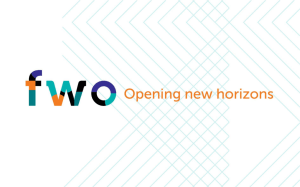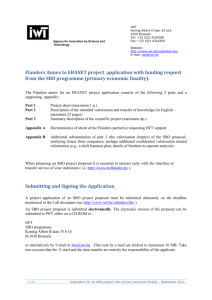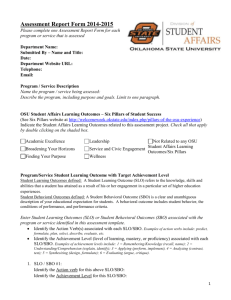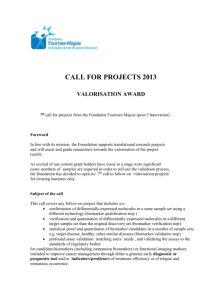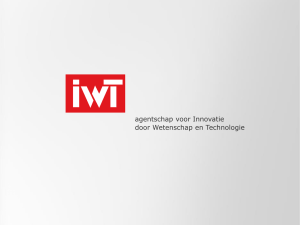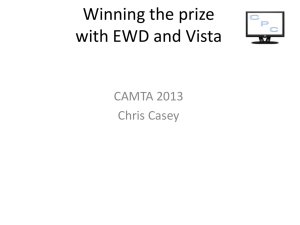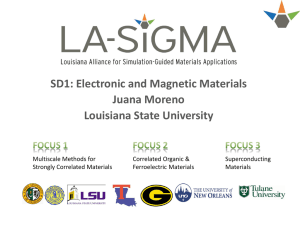The application
advertisement
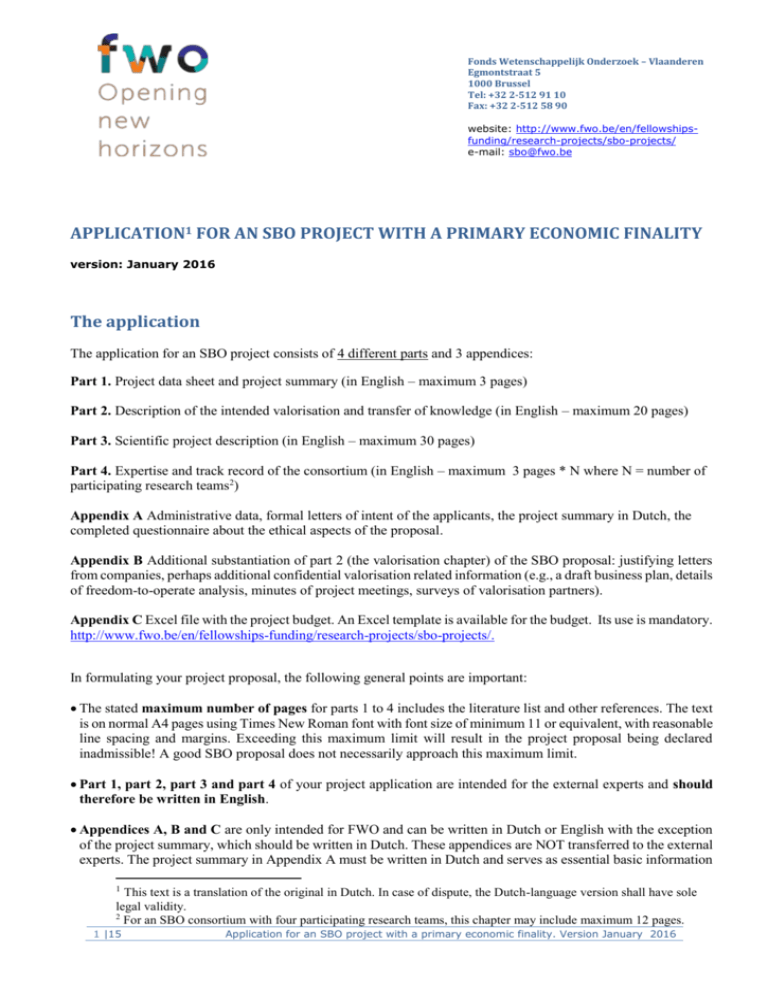
Fonds Wetenschappelijk Onderzoek – Vlaanderen Egmontstraat 5 1000 Brussel Tel: +32 2-512 91 10 Fax: +32 2-512 58 90 website: http://www.fwo.be/en/fellowshipsfunding/research-projects/sbo-projects/ e-mail: sbo@fwo.be APPLICATION1 FOR AN SBO PROJECT WITH A PRIMARY ECONOMIC FINALITY version: January 2016 The application The application for an SBO project consists of 4 different parts and 3 appendices: Part 1. Project data sheet and project summary (in English – maximum 3 pages) Part 2. Description of the intended valorisation and transfer of knowledge (in English – maximum 20 pages) Part 3. Scientific project description (in English – maximum 30 pages) Part 4. Expertise and track record of the consortium (in English – maximum 3 pages * N where N = number of participating research teams2) Appendix A Administrative data, formal letters of intent of the applicants, the project summary in Dutch, the completed questionnaire about the ethical aspects of the proposal. Appendix B Additional substantiation of part 2 (the valorisation chapter) of the SBO proposal: justifying letters from companies, perhaps additional confidential valorisation related information (e.g., a draft business plan, details of freedom-to-operate analysis, minutes of project meetings, surveys of valorisation partners). Appendix C Excel file with the project budget. An Excel template is available for the budget. Its use is mandatory. http://www.fwo.be/en/fellowships-funding/research-projects/sbo-projects/. In formulating your project proposal, the following general points are important: The stated maximum number of pages for parts 1 to 4 includes the literature list and other references. The text is on normal A4 pages using Times New Roman font with font size of minimum 11 or equivalent, with reasonable line spacing and margins. Exceeding this maximum limit will result in the project proposal being declared inadmissible! A good SBO proposal does not necessarily approach this maximum limit. Part 1, part 2, part 3 and part 4 of your project application are intended for the external experts and should therefore be written in English. Appendices A, B and C are only intended for FWO and can be written in Dutch or English with the exception of the project summary, which should be written in Dutch. These appendices are NOT transferred to the external experts. The project summary in Appendix A must be written in Dutch and serves as essential basic information 1 This text is a translation of the original in Dutch. In case of dispute, the Dutch-language version shall have sole legal validity. 2 For an SBO consortium with four participating research teams, this chapter may include maximum 12 pages. 1 |15 Application for an SBO project with a primary economic finality. Version January 2016 for the steering evaluation committee and the FWO Board of Directors. This document also serves as a basis for formulating the grant agreement in the case of a positive decision. Please formulate this Dutch summary very carefully and in line with the other parts of your SBO project proposal. Please note that no other appendices are requested than the above-mentioned Appendices A, B and C. Nonrequested appendices (such as e.g. scientific addenda, CVs of researchers, etc.) are not used in the evaluation process. This template contains only the basic information for formulating an SBO proposal. You will find additional information in the SBO Handbook and the SBO Call document on the website (http://www.fwo.be/en/fellowships-funding/research-projects/sbo-projects/). When preparing an SBO project proposal it is essential to interact early with the interface or transfer office of your institution (cf. http://www.ttoflanders.be). Preliminary registration Project applicants must make a preliminary registration of their project application by a specified date indicated in the Call document (http://www.fwo.be/en/fellowships-funding/research-projects/sbo-projects/). This preliminary registration must contain the following information: the title of the project, a brief summary of the project (approx. half a page), any experts to be excluded (max. 5), the project partners and the project coordinator. This information will be retrieved to allow the FWO staff to prepare the evaluation process as efficiently as possible. The information must be sent by e-mail via sbo@fwo.be. Submitting and signing the application A project application for an SBO project proposal must be submitted by the deadline indicated in the Call document (http://www.fwo.be/en/fellowships-funding/research-projects/sbo-projects/). An SBO project proposal is submitted electronically by e-mail to sbo@fwo.be. The maximum e-mail size is 15 MB and the sending of the e-mail and the data transfer is at the sole risk of the applicant. It is required to submit 3 separate files: one electronic file with Parts 1 to 4 intended for the external experts (as a PDF or a Word file), one electronic file with Appendices A and B intended for FWO (as a PDF or a Word file), one electronic file with the Excel file of the project budget intended for FWO (editable Excel file). The project leader is required to keep the letters with original signatures available. 2 |15 Application for an SBO project with a primary economic finality. Version January 2016 Part 1 General Data: Project Data Sheet and Project Summary This part contains maximum 3 pages. 1.1 Title of the project. - title (short, informative and clear) 1.2 Basic data - the primary nature of the valorisation finality of the project: economic with transfer to existing companies economic with creation of a spin-off company Note: You have to make an explicit choice (cf. handbook); - Start date (1 January 2017 – 31 December 2017): - Project duration (max. 4 years): - Total requested subsidy (€): - Total number of man-months (mm): - Project partners: enumeration of the participating research groups in the consortium (listed by legal entity) and names of the promoters or project leaders (i.e. without further administrative data) 1.3 Summary of scientific goals (max. 1 page) General goal: Describe in one or two sentences what the consortium wants to achieve with the proposed project. The general purpose is in essence the innovation to be achieved in terms of product, process and/or service. Concrete objectives and criteria: Indicate explicitly the partial results to be achieved at the end of the project. These may include new knowledge/insights to be acquired or the solution of specific problems or the realisation of concrete equipment, test set-ups, models, etc. List by sub-aspect the main quantitative and qualitative benchmarks, criteria, requirements or standards, in order to be able to determine at the end of the project to what extent the expected results have been obtained. 1.4. Summary of potential impact (valorisation) max. 1 page Describe briefly the valorisation perspectives: - 3 |15 Which applications/sectors are envisaged? What potential impact is expected? How will the results be transferred (e.g. by bilateral follow-on R&D projects, company internships, licensing, creation of a new spin-off company, etc.). If a new spin-off company is envisaged, shortly describe the proposed business model. Describe the IPR strategy Application for an SBO project with a primary economic finality. Version January 2016 Give an overview of all companies that have agreed to participate in the advisory committee and to actively cooperate during and after the project (if relevant). Briefly describe their potential role in the valorisation chain and their contribution (financial, in kind) to the project: E.g. - 4 |15 Company X (raw material supplier, €1,000/year + test material); Company Y (technology supplier, SME, €250/year) Company Z (product development, €1,000/year + parallel R&D activities) Application for an SBO project with a primary economic finality. Version January 2016 Part 2. Description of the intended valorisation and knowledge transfer This part contains maximum 20 pages. The assessment of the valorisation chapter of an SBO project proposal is an essential aspect in the selection of an SBO project. This assessment aspect is essential to estimate the potential future economic value creation for Flanders. This requires an adequately elaborated valorisation chapter including, wherever possible, quantitative indications, although the valorisation can only be achieved in the future. The task of the applicants is to conceptualise an optimum valorisation track. The key questions here are: What do I want to valorise? Which companies are candidates for transfer? How do I tackle valorisation? It is essential that you explain your arguments well in your project proposal. In appendix B, you can add supporting information, such as well-founded expressions of interest and commitments by the companies that will participate in the advisory committee. 2.1. Rationale (including the preparatory phase and the wider valorisation framework) In this section describe the process of how you came about to realise this project proposal and the attention that you devoted to the valorisation focus of the project proposal and the interaction dynamics with the users. Which preliminary interactions with which users (companies) did you have in preparing your project proposal? Which impact did this have on the further realisation of your project proposal? You can illustrate the preparatory phase that you carried out based on a work plan, reports and a performance sheet for the activities that you undertook during the preparation phase. Within which wider valorisation framework is your SBO proposal positioned? 2.2. Valorisation potential and valorisation objectives of the project Which current problems or challenges to several companies do you want to tackle? or/and Which economic opportunities might be created by the anticipated scientific breakthrough? Furthermore, indicate how the intended results of the SBO project will contribute to solving a problem and/or realising the economic opportunities. Formulate the valorisation objectives as concretely as possible and in line with the intended project results and the interaction dynamics with the users. Examine the economic value chains and the scenarios for the further continuation of the valorisation track. How large is the market/relevance of the applications? It is essential here to clarify which companies or industrial sectors comprise the target group for valorisation, and why. Do not provide merely a list of companies, but clarify why the project results are important for these companies. Where appropriate, distinguish between the potential application domains or add a matrix in which you indicate which companies have an interest in which partial results of the project (for example, as links in a value chain). To what extent will (present or future) companies in Flanders be able to actually use the results of the project? Which R&D post-project track is necessary in these companies in order to achieve effective economic valorisation? All the descriptions must be quantified as much as possible. Finally, provide an overview of the environmental factors (for example, regulations and policy measures) that could reinforce the economic valorisation potential. 5 |15 Application for an SBO project with a primary economic finality. Version January 2016 2.3. Valorisation strategy and valorisation approach of the project Based on the valorisation potential, you subsequently develop a concrete valorisation strategy and valorisation approach. Which activities will you undertake to support the transfer of your research results to industrial practice? This is not only about making a list of the activities, but also explain why you specifically think that these activities will contribute to valorisation. Demonstrating meaningful interactions with the target groups and active efforts by the project consortium toward achieving valorisation is highly important during the assessment. Regarding an anticipated transfer (of knowledge) to existing companies, it is important to indicate which intentions (and IP-agreements, if relevant) you have about the anticipated interactions with the companies. In order not to disturb the dynamics of the advisory committee, non-exclusive access to the results is to be preferred. In a number of sectors, however, this will not be feasible. In these sectors and domains where exclusivity of transfer/licensing is common and obvious, your vision on the way you will interact with the individual companies is highly relevant. Clearly indicate whether you aim for exclusivity (in a certain domain) towards the companies or not + motivate your choice. Will this have an impact on the dynamics in the advisory committee? Explain. Make these choices in interaction with the transfer office of your institution. Provide an overview of ongoing and planned R&D cooperations with companies from the advisory committee that are related to the subject of this project. Substantiate these cooperations by means of a cooperation agreement or an explanation in the letters of intent from the company (Appendix B). In projects where the valorisation strategy is focused on creating a new (yet to be established) spin-off company by a research organisation (spin-off earmarked project), it is important to thoroughly elaborate and substantiate the business concept, the strategy and the approach for further development of the spin-off. Explain (both in the context of a transfer to existing companies as in the context of the creation of a spin-off company) which mutual valorisation agreements and agreements with regard to IP-distribution have been made between the consortium partners and explain how these agreements facilitate the efficient operation of the research collaboration and of the further valorisation process3? If the research consortium executes parallel R&D activities with a company from the advisory committee and if these activities are related to the subject of this project, explain the impact of this cooperation on the valorisation possibilities of the other companies in the advisory committee and on the dynamics in the advisory committee. Also elaborate on the potential risk factors (e.g., intellectual property rights (IPR), freedom to operate (FTO), legal regulations, availability of research data, or infrastructure, etc.) that might hamper the valorisation opportunities in Flanders. In particular, give an overview of the most relevant existing patents and the possible impact of these patents on the freedom to operate. If such risk factors exist, indicate how you will deal with them. 2.4. Added value in the area of sustainable development (if applicable) Finally, in the project application it is important to adequately justify and substantiate the contribution of the project to sustainable development, if this is relevant. For the time being, the definition of sustainability is limited to the contribution to environmental improvement and it is connected to the 8 postulated environmental innovation objectives as described in the Sustainable Development (SD) Guidelines for industrial projects at the Agency for Innovation and Entrepreneurship4: resource savings; energy savings; reducing emissions of environmentally harmful substances; reducing waste and other environmental impacts; increasing the use of renewable resources; re-use of raw materials and increasing the recyclability of materials and products; increasing the lifespan of products and processes, increasing safety and health at work. A project proposal can be earmarked as an SD project if the applicants can demonstrate that the majority of the R&D follow-up projects to be expected after the SBO project qualify as SD earmarked projects in accordance with the current evaluation 3 As part of the project proposal in Appendix B, a term sheet is required between the partners of the consortium with minimally the mutual agreement concerning the management and the allocation of the IPR. This term sheet is prepared based on prior interaction with the TTO services and duly signed by a legal representative of the participating institutions. The deadline for submission of the term sheet (indicative size 1 A4 page) is indicated in the call document. 4 For a description of the methodology, reference is made to http://www.fwo.be/en/fellowships-funding/researchprojects/sbo-projects/. 6 |15 Application for an SBO project with a primary economic finality. Version January 2016 process for SD earmarking of industrial R&D projects at the Agency for Innovation and Entrepreneurship (www.vlaio.be). Just as with the economic valorisation perspectives, the environmental benefits to be expected in the medium term have to be demonstrated on the basis of the R&D activities that follow in the wake of a successful SBO project. 7 |15 Application for an SBO project with a primary economic finality. Version January 2016 Part 3. Scientific project description This part contains maximum 30 pages. 3.1 Rationale Starting from the intended valorisation objectives of your project, describe the scientific motivation for the project based on scientific knowledge gaps, and the issues and problems that you want to solve with this project. Indicate why the implementation of the strategic basic research is essential. 3.2. Positioning with regard to the scientific state-of-the-art Describe concisely the situation of the academic and patent-related literature in the domain of the project, together with the most important sources. Which background information is available at the start of the project? Position your project with regard to the scientific state-of-the-art and in relation to ongoing national and international research. Clarify how your project complements and overlaps with these developments. 3.3. Scientific project objectives Describe as explicitly as possible the scientific project objectives that you wish to reach in this project proposal. What is the essence of the intended scientific progress from which the various concrete goals, criteria, activities and the desired results can be understood? List explicitly the results (or partial results) that will have to be achieved, such as specific knowledge, the solution to particular problems and the academic breakthroughs. Per sub-aspect, mention the major quantitative (preferably) and qualitative target values, criteria, requirements and norms that at the end of the project could determine to what extent the anticipated results were reached. 8 |15 Application for an SBO project with a primary economic finality. Version January 2016 3.4. Research approach and work plan Describe how the research project will be tackled and justify why this approach was selected and why any specific strategic choices were made. The approach should clarify how the scientific objectives will be reached, taking into account the proposed (sub)objectives and criteria, and the capabilities of the partners. From the perspective of this general approach, describe the set-up and cohesion of the work packages and the milestones. Also state how interim decision points and general project risks are taken into account. Describe in the work plan: WHAT (divided into work packages), WHY and HOW (research approach, work method), WHEN (planning) and WHO (division of tasks, synergy and complementarity). Add a Gantt graph for clarification. Indicate how the coordination and monitoring of the project will be organised and how the cooperation among the various partners will be structured. Finally provide an overview of the deployed man-months per year. Use the table below. Overview of the deployed man-months WP 1 Partner Year 1 Partner 1 Partner 2 … Year 2 Year 3 Year 4 TOTAL 2 … TOTAL 9 |15 Application for an SBO project with a primary economic finality. Version January 2016 3.5. Project budget/requested support The project budget is based on the real costs and prepared according to the principles of the cost model (http://www.fwo.be/en/fellowships-funding/research-projects/sbo-projects/). An Excel template is available for the budget. Its use is mandatory (http://www.fwo.be/en/fellowships-funding/research-projects/sbo-projects/). Only the global overview is copied to this section 3.5 of the application template and integrated into the PDF file for the experts. 10 |15 Application for an SBO project with a primary economic finality. Version January 2016 Part 4. Expertise and track record of the consortium Fill in this part per participating research team. This part is maximum 3 pages * N where N=number of participating research teams. 4.1. Scientific expertise and track record Per project partner, indicate the scientific expertise and the resources (personnel, infrastructure, access to information/IPR, etc.) of each partner, which will contribute effectively to the implementation of the SBO project. Justify your choice for including this research team in the consortium and indicate the expected synergy (or synergies) with the other research teams. Demonstrate the scientific expertise that is the most relevant for the central problem-definition of the SBO project based on the five most important publications. Discuss previous, current and planned research projects that connect specifically to the SBO project proposal at hand with indication of the financing mechanism (Flemish, federal, European Union support, bilateral contract with a company, etc.). Provide a concise interpretation of the crucial academic successes or breakthroughs that these previous projects achieved. Also add an overview of the relationship and the complementary aspect between the SBO project application and these related research activities. Also discuss your management experience with conducting multi-partner research projects (useful management experience does not necessarily come from the specific subject of the SBO project). 4.2. Valorisation expertise and track record Show which competences and experiences each research team (i.e. not at the higher level of the institute or the department) in the consortium has in the area of transferring research results to valorisation partners. This useful experience does not necessarily come from within the subject of the SBO project. When describing the experiences, relevant issues are: To what extent in the past has the project partner participated in industrial R&D activities of companies or of other forms of industrial services? Have the project implementers contributed in the past to establishing new spin-offs? Are there patents that have already led to a transfer to companies? Are there data available about the economic impact of the transfer on the companies to which the transfer was made? Which valorisation performances did the project partner achieve with previous and current SBO projects? Have previous and current SBO projects already led to subsequent R&D activities and further industrial developments in companies? 11 |15 Application for an SBO project with a primary economic finality. Version January 2016 Appendix A. Administrative data and formal letters of intent from the applicants, project summary in Dutch, questionnaire about ethical aspects A.1 Project coordinator - Applying research organisation (university, university college, etc.); Name of the research team; Department or unit under which the research team falls; Last name, first name, title and function of the project coordinator (promoter or supervisor) and, where appropriate, also the operational project leader (i.e. the person who will undertake the daily management of the project); - Other contact persons; - Addresses; - Telephone number, e-mail address, Internet website A.2. Project partners Together with the project coordinator, these constitute the research consortium. For each project partner/research team: - Applying research organisation (institution); Name of the research team; Department or unit under which the research team falls; First name, last name and function of the contact person; Addresses; Telephone number, e-mail address, Internet website A.3. Subcontractors (if applicable) - Applying research organisation or company; First name, last name and function of the contact person; Addresses; Telephone number, e-mail address, Internet website VAT number (in case of a company) 12 |15 Application for an SBO project with a primary economic finality. Version January 2016 A.4. Formal letters of intent from the project coordinator (referred to in A1) and the project partners (referred to in A2) Each SBO project application shall also include a signed letter of intent per participating legal entity that applies for a project (project coordinator or project partner), whereby the authorised representative of the institution agrees to the application and authorises FWO to carry out the necessary enquiries as part of the project evaluation. In the case of a university, the rector is usually the authorised person. The following text must appear on official stationary with the letterhead of the institute. In the case of non-Flemish R&D parties, the letter of intent can be written in English. “As authorised by <name of legal entity that applies for the project> I declare that I am familiar with and agree to the project application “<title of the project>“ submitted under the SBO funding programme by <name of project coordinator> affiliated with <name of institution, department or unit>, and in cooperation with <name and affiliation of the participating partners>5. The <name of legal entity that applies for the project> has also studied the modalities of the SBO funding programme, as described in the Call Document 2016 and the SBO Handbook, version January 2016. The undersigned confirms his intention to carry out his own part of the work and to cooperate with the partners 6 under this project in accordance with the plan and hereby authorises FWO to carry out any necessary enquiries that are required for the evaluation of this project application. The undersigned also confirms that the project application fits in with the objectives of the SBO funding programme and is not financed via any other funding channels. “The <name of legal entity that applies for the project> hereby declares that it fully complies with the definition of a research organisation, as defined in Article 2 (83) of the Regulation (EU) No. 651/2014 of the Commission of 17 June 20147. A.5. Project summary in Dutch The content of this text is completely identical to the English text in paragraphs 1.3 and 1.4 of Part 1. The substantive project summary in Dutch contains the following two parts with maximum 1 page per part (i.e. max. 2 A4 pages for both parts): a concise summary of the scientific objectives of the project; a concise summary of the potential impact of the project. 5 if applicable if applicable 7 an entity (such as universities or research institutions, technology transfer agencies, innovation intermediaries, research-oriented physical or virtual collaborative entities), irrespective of its legal status (organised under public or private law), or way of financing, whose primary goal is to independently conduct fundamental research, industrial research or experimental development, or to widely disseminate the results of such activities by way of teaching, publication or knowledge transfer. Where such entity also pursues economic activities, the financing, the costs and the revenues of those economic activities must be accounted for separately. Undertakings that can exert a decisive influence upon such an entity, for example in the quality of shareholders or members, may not enjoy a preferential access to the research capacity of that entity or to the results generated by it. 6 13 |15 Application for an SBO project with a primary economic finality. Version January 2016 ETHICS Please complete this questionnaire. If you have indicated "Yes" for at least one of the items below, you must submit your proposal to the research ethics committee of your host institution for ethical clearance, AS SOON AS you receive the outcome of the funding decision. There is no obligation to upload the ethical clearance beforehand. I confirm that none of the issues below apply to my proposal. I hereby confirm having taken note that an ethical clearance is needed for the start of my project. I will thus ensure submission of my proposal to the research ethics committee of my host institution. I hereby confirm that I’ve already submitted an application for an ethical clearance at the local ethical committee of my host institution. Please specify which ethical committee(s) will deal with your application.(Optional) Does your research involve Human Embryonic Stem Cells (hESCs)? Does your research involve the use of human embryos? Does your research involve the use of human foetal tissues / cells? Does your research involve human participants? Does your research involve volunteers for social or human sciences research? Does your research involve persons unable to give informed consent? Are they vulnerable individuals or groups? Does your research involve children/minors? Does your research involve patients? Does your research involve healthy volunteers for medical studies? Does your research involve physical interventions on human study participants? Does your research involve invasive techniques on human study participants? Does it involve collection of biological samples of human study participants? Does your research involve human cells or tissues (other than from Human Embryos/Foetuses, i.e. section)? Does your research involve personal data collection and/or processing? Does it involve the collection and/or processing of sensitive personal data (e.g.: health, sexual lifestyle, ethnicity, political opinion, religious or philosophical conviction)? Does it involve collecting/processing of genetic information/data? Does it involve tracking or observation of participants? Does your research involve further processing of previously collected personal data (secondary use)? Does your research involve animals? Does your research involve vertebrates? Does your research involve non-human primates? Does your research involve genetically modified animals? Does your research involve cloned farm animals? Does your research involve endangered species? Do you plan to use local resources (e.g. animal and/or human tissue samples, genetic material, live animals, human remains, materials of historical value, endangered fauna or flora samples, etc.)? If your research involves low and/or lower middle income countries, are benefits-sharing measures foreseen? Could the situation in the country put the individuals taking part in the research at risk? Does your research involve the use of elements that may cause harm to the environment, to animals or plants? Does your research deal with endangered fauna and/or flora and/or protected areas? Does your research involve the use of elements that may cause harm to humans, including research staff? Does your research have the potential for military applications? Does your research have the potential for malevolent/criminal/terrorist abuse? Are there any other ethics issues that should be taken into consideration? Please specify 14 |15 Application for an SBO project with a primary economic finality. Version January 2016 Appendix B. Additional substantiation of Part 2 (the valorisation chapter) of the SBO proposal As part of the project proposal, a term sheet is required between the partners of the consortium with minimally the mutual agreement concerning the management and the allocation of the IPR. This agreement reflects the IP agreements as mentioned in 2.3. When deviations from these agreements in 2.3. are intended, these are substantiated in the term sheet. This term sheet is prepared based on prior interaction with the TTO services and duly signed by a legal representative of the participating institutions. The deadline for submission of the term sheet (indicative size 1 A4 page) is indicated in the call document. For a project with anticipated transfer to existing companies: The substantiated letters of intent of companies with a commitment to engage themselves in the advisory committee. These letters should preferably be submitted as completely as possible already at the time of submitting the project. Any letters of intent that may be missing can still be submitted later; the deadline for submission of these letters of intent is indicated in the call document. - It is essential that the letters are properly substantiated and not limited to general non-binding expressions of interest. Invite the companies to clarify the possible valorisation opportunities of a successful SBO-project in a clear and explicit manner and have them reflect and elaborate on the anticipated follow-up R&D activities and on concepts for future business cases. - The letter of intent for membership of the advisory committee must be signed by a legal representative of the company. This enhances the support base of the company for the commitment in the advisory committee. - For project proposals with anticipated transfer to existing companies, a limited financial contribution by the companies of the advisory committee is mandatory. The financial contribution is defined as follows: the input by all members of the advisory committee of a cash contribution of €250/year for an SME and of €1000/year for a large company or another organisation. A demonstrable equivalent deployment of manpower and resources for the execution of the project may also be taken into consideration. - A higher contribution than the minimal required amounts is not obligatory, but can be positively assessed in the evaluation of the proposal. For spin-off earmarked project proposals, there is no obligation for a financial input from the work field. If applicable, the documentation of parallel R&D collaborations with companies of the advisory committee. In the case of a planned new spin-off company: additional confidential information such as a concept business plan. Available additional valorisation related information such as the result of an FTO analysis. Optional: short list of maximum 5 experts to be avoided. To avoid any possible conflict of interest mainly from industrial competition and to allow for an impartial and balanced evaluation, applicants may submit to FWO a short list of a maximum of 5 experts to be avoided. This holds especially for industrial experts or possibly also experts from research organisations insofar as they have a significant affiliation with a competitive company or spin-off development. The short list must be specific i.e. based on the name of the expert or at least of his or her research team or department. It is not possible to exclude experts at the higher level of a research organisation or university, or to challenge experts which are active in a particular domain. 15 |15 Application for an SBO project with a primary economic finality. Version January 2016
